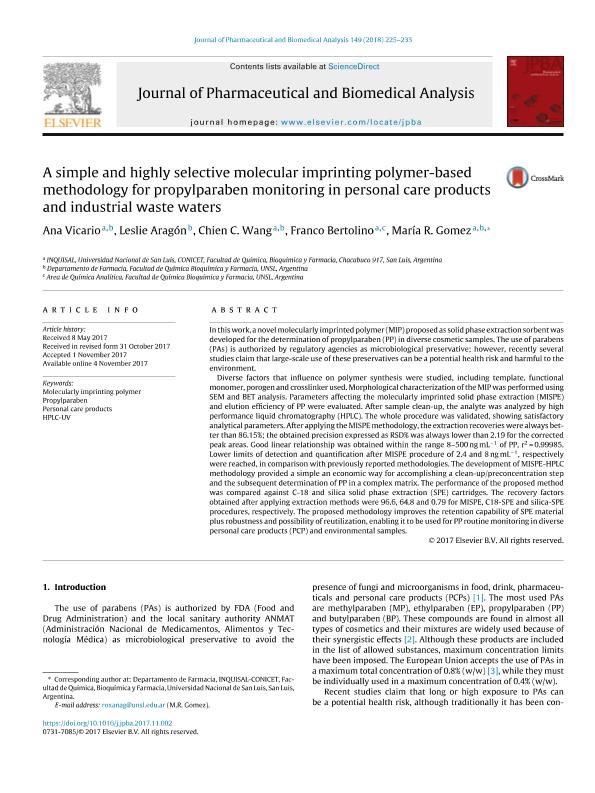Artículo
A simple and highly selective molecular imprinting polymer-based methodology for propylparaben monitoring in personal care products and industrial waste waters
Vicario, Ana Laura ; Aragón, Leslie; Wang, Chien Chun
; Aragón, Leslie; Wang, Chien Chun ; Bertolino, Franco Adrián
; Bertolino, Franco Adrián ; Gomez, Maria Roxana Anabel
; Gomez, Maria Roxana Anabel
 ; Aragón, Leslie; Wang, Chien Chun
; Aragón, Leslie; Wang, Chien Chun ; Bertolino, Franco Adrián
; Bertolino, Franco Adrián ; Gomez, Maria Roxana Anabel
; Gomez, Maria Roxana Anabel
Fecha de publicación:
04/02/2018
Editorial:
Elsevier Science
Revista:
Journal of Pharmaceutical and Biomedical Analysis
ISSN:
0731-7085
e-ISSN:
0731-7085
Idioma:
Inglés
Tipo de recurso:
Artículo publicado
Clasificación temática:
Resumen
In this work, a novel molecularly imprinted polymer (MIP) proposed as solid phase extraction sorbent was developed for the determination of propylparaben (PP) in diverse cosmetic samples. The use of parabens (PAs) is authorized by regulatory agencies as microbiological preservative; however, recently several studies claim that large-scale use of these preservatives can be a potential health risk and harmful to the environment. Diverse factors that influence on polymer synthesis were studied, including template, functional monomer, porogen and crosslinker used. Morphological characterization of the MIP was performed using SEM and BET analysis. Parameters affecting the molecularly imprinted solid phase extraction (MISPE) and elution efficiency of PP were evaluated. After sample clean-up, the analyte was analyzed by high performance liquid chromatography (HPLC). The whole procedure was validated, showing satisfactory analytical parameters. After applying the MISPE methodology, the extraction recoveries were always better than 86.15%; the obtained precision expressed as RSD% was always lower than 2.19 for the corrected peak areas. Good linear relationship was obtained within the range 8–500 ng mL−1 of PP, r2 = 0.99985. Lower limits of detection and quantification after MISPE procedure of 2.4 and 8 ng mL−1, respectively were reached, in comparison with previously reported methodologies. The development of MISPE-HPLC methodology provided a simple an economic way for accomplishing a clean-up/preconcentration step and the subsequent determination of PP in a complex matrix. The performance of the proposed method was compared against C-18 and silica solid phase extraction (SPE) cartridges. The recovery factors obtained after applying extraction methods were 96.6, 64.8 and 0.79 for MISPE, C18-SPE and silica-SPE procedures, respectively. The proposed methodology improves the retention capability of SPE material plus robustness and possibility of reutilization, enabling it to be used for PP routine monitoring in diverse personal care products (PCP) and environmental samples.
Archivos asociados
Licencia
Identificadores
Colecciones
Articulos(INQUISAL)
Articulos de INST. DE QUIMICA DE SAN LUIS
Articulos de INST. DE QUIMICA DE SAN LUIS
Citación
Vicario, Ana Laura; Aragón, Leslie; Wang, Chien Chun; Bertolino, Franco Adrián; Gomez, Maria Roxana Anabel; A simple and highly selective molecular imprinting polymer-based methodology for propylparaben monitoring in personal care products and industrial waste waters; Elsevier Science; Journal of Pharmaceutical and Biomedical Analysis; 149; 4-2-2018; 225-233
Compartir
Altmétricas



